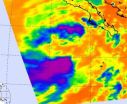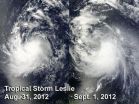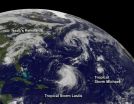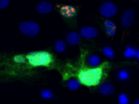(Press-News.org) Irvine, Calif., Sept. 4, 2012 – Repeated exposure to violent images from the terrorist attacks of Sept ember 11 and the Iraq War led to an increase in physical and psychological ailments in a nationally representative sample of U.S. adults, according to a new UC Irvine study.
The study sheds light on the lingering effects of "collective traumas" such as natural disasters, mass shootings and terrorist attacks. A steady diet of graphic media images may have long-lasting mental and physical health consequences, says study author Roxane Cohen Silver, UCI professor of psychology & social behavior, medicine and public health.
"I would not advocate restricting nor censoring war images for the psychological well-being of the public," Silver said. "Instead, I think it's important for people to be aware that there is no psychological benefit to repeated exposure to graphic images of horror."
People who watched more than four hours a day of 9/11 and Iraq War-related television coverage (in the weeks after the attacks and at the start of the war) reported both acute and post-traumatic stress symptoms over time. Those who watched more than four hours a day of 9/11-related coverage in the weeks after the attacks reported physician-diagnosed physical health ailments two to three years later.
Seeing two particular kinds of images in the early days of the Iraq War was associated with post-traumatic stress symptoms over time: soldiers engaged in battle and dead U.S. and Allied soldiers.
The study included assessments of participants' mental and physical health before the 9/11 attacks and information about their media exposure and acute stress responses immediately after the attacks and after the initiation of the Iraq War. Researchers conducted follow up assessments in the three years after 9/11.
The acute stress period refers to the first few weeks after the event and post-traumatic stress is any time after one month. Researchers started to measure stress nine to 14 days after 9/11 and within a few days after the start of the Iraq War.
Almost 12 percent of the 1,322 participants reported high levels of acute stress related to 9/11 and about 7 percent reported high levels of acute stress related to the Iraq War. After taking pre-9/11 mental health, demographic characteristics, and lifetime trauma exposure into account, people who watched four or more hours of 9/11-or Iraq War-related television were more likely to experience symptoms of acute stress.
"The results suggest that exposure to graphic media images may be an important mechanism through which the impact of collective trauma is dispersed widely," Silver says. "Our findings are both relevant and timely as vivid images reach larger audiences than ever before through YouTube, social media and smartphones."
Funded by the National Science Foundation, the study appears in a forthcoming issue of Psychological Science, the flag-ship journal of the Association for Psychological Science. It was co-authored by Alison Holman, assistant professor of nursing at UCI, Judith Pizarro Andersen of the University of Toronto, Mississauga, Michael Poulin of the University at Buffalo, Daniel McIntosh of the University of Denver and Virginia Gil-Rivas of the University of North Carolina, Charlotte.
"When we consider that graphic images of individuals being overcome by the 2011 tsunami in Japan were shown repeatedly, that a vigorous debate occurred last year regarding the release of the gruesome death photos of Osama bin Laden, and that vivid and disturbing images of 9/11 will likely appear on our television screens marking the anniversary of the attacks, we believe that our paper has something important to say regarding the impact of repeated exposure to graphic traumatic images," Silver said.
INFORMATION:
About the University of California, Irvine: Founded in 1965, UCI is a top-ranked university dedicated to research, scholarship and community service. Led by Chancellor Michael Drake since 2005, UCI is among the most dynamic campuses in the University of California system, with nearly 28,000 undergraduate and graduate students, 1,100 faculty and 9,000 staff. Orange County's second-largest employer, UCI contributes an annual economic impact of $4 billion. For more UCI news, visit www.today.uci.edu.
News Radio: UCI maintains on campus an ISDN line for conducting interviews with its faculty and experts. Use of this line is available for a fee to radio news programs/stations that wish to interview UCI faculty and experts. Use of the ISDN line is subject to availability and approval by the university.
UCI maintains an online directory of faculty available as experts to the media. To access, visit www.today.uci.edu/experts.
NOTE TO EDITORS: Photo available at http://today.uci.edu/news/2012/09/nr_roxysilver_120904.php
END
A North Carolina State University researcher has created a roadmap to areas of the brain associated with affective aggression in mice. This roadmap may be the first step toward finding therapies for humans suffering from affective aggression disorders that lead to impulsive violent acts.
Affective aggression differs from defensive aggression or premeditated aggression used by predators, in that the role of affective aggression isn't clear and could be considered maladaptive. NC State neurobiologist Dr. Troy Ghashghaei was interested in finding the areas of the brain engaged ...
Vitamin D has been touted for its beneficial effects on a range of human systems, from enhancing bone health to reducing the risk of developing certain cancers. But it does not improve cholesterol levels, according to a new study conducted at The Rockefeller University Hospital. A team of scientists has shown that, at least in the short term, cholesterol levels did not improve when volunteers with vitamin D deficiency received mega-doses of vitamin D. The finding is published in the journal Arteriosclerosis, Thrombosis and Vascular Biology.
The researchers, led by Manish ...
BEER-SHEVA, ISRAEL, September 4, 2012 -- Ben-Gurion University of the Negev (BGU) researchers have determined that preeclampsia is a significant risk factor for long-term health issues, such as chronic hypertension and hospitalizations later in life. The findings from the retrospective cohort study were just published in the Journal of Maternal-Fetal and Neonatal Medicine.
Thousands of women and their babies die or get very sick from preeclampsia; it affects approximately 5 to 8 percent of all pregnancies. It is a rapidly progressive condition characterized by high blood ...
HOUSTON – Biologic therapies developed in the last decade for rheumatoid arthritis are not associated with an increased risk of cancer when compared with traditional treatments for the condition, according to new research from The University of Texas MD Anderson Cancer Center.
The study, published in The Journal of the American Medical Association (JAMA), is the largest systematic review evaluating the risk of developing any malignancy among rheumatoid arthritis patients using approved biologic response modifiers (BRMs), several of which include tumor necrosis factor ...
(Edmonton) University of Alberta led research shows an elk's personality type is a big factor in whether or not it survives the hunting season.
Data collected from GPS collars on more than 100 male and female elk in southwestern Alberta showed U of A researchers the study population could be divided into two categories: bold runners and shy hiders:
Bold-runner elk, both males and females, moved quickly through the study area and preferred to graze in open fields for the most abundant and nutritious grass. GPS data showed shy hiders stayed and grazed on the sparse vegetation ...
The protection of the savings of the elderly—one of the primary goals of Medicare—is under threat from a combination of spiraling healthcare costs and increased longevity. As the government attempts to reduce Medicare costs, one suggestion is that the elderly could pay a larger proportion of the costs of their healthcare. But exactly how much would this be and what impact would it have on their finances? A new study by Amy Kelley at the Mount Sinai School of Medicine and her colleagues, funded by the National Institute on Aging, aims to identify the portion of wealth ...
Tropical Storm John had about one day of fame in the Eastern Pacific. Born Tropical Depression 10, it intensified into Tropical Storm John on Sept. 2 at 5 a.m. EDT and maintained maximum sustained winds of 40 mph (65 kmh) until it weakened back into a depression on Monday, Sept. 3 at 11 p.m. EDT.
NASA's Aqua satellite flew over John on Sept. 3 at 2041 UTC (4:41 p.m. EDT) during its brief time as a tropical storm and noticed convection (rising air that forms thunderstorms that make up the storm) and coldest cloud top temperatures seemed to be limited to the northeastern ...
Over the weekend of Aug. 31 to Sept. 2, Tropical Storm Leslie's maximum sustained winds were pretty constant and satellite imagery from NASA's Aqua and Terra satellites confirm the steadiness of the storm. That story is expected to change later this week however, as Leslie nears Bermuda and is expected to reach hurricane strength. Meanwhile, Leslie is still about the same strength today, Sept. 4 because of wind shear.
Two visible images from the Moderate Resolution Imaging Spectroradiometer or MODIS instrument that flies onboard both of NASA's Aqua and Terra satellites ...
Tiny Tropical Storm Michael formed today, Sept. 4, from the thirteenth tropical depression in the Atlantic Ocean, but it seems that wind shear will make Michael struggle to intensify over the next couple of days like his "sister" Tropical Storm Leslie. Isaac's remnants blanket the U.S. east coast.
Leslie has been a tropical storm since late Aug. and has not yet reached hurricane strength because of wind shear, although that is expected to change. Isaac's remnants are also struggling, but struggling to get off the land and back into the Atlantic Ocean. Isaac's remnants ...
JUPITER, FL - Scientists on the Florida campus of The Scripps Research Institute have designed a compound that shows promise as a potential therapy for one of the diseases closely linked to fragile X syndrome, a genetic condition that causes mental retardation, infertility, and memory impairment, and is the only known single-gene cause of autism.
The study, published online ahead of print in the journal ACS Chemical Biology September 4, 2012, focuses on tremor ataxia syndrome, which usually affects men over the age of 50 and results in Parkinson's like-symptoms—trembling, ...



